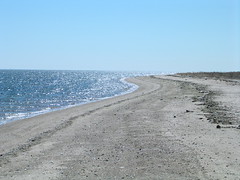Protecting Threatened Birds in West Haven
I had noted that at Milford Point, which is part of the Stewart B. McKinney National Wildlife Refuge, a snow fence keeps people away from the plovers' nesting area from, roughly, April through the summer, and that at Griswold Point, the Nature Conservancy erects circular fences around each nest to keep predators out. My recommendation for Sandy Point, a place much easier to get to than Griswold Point, was to close it off to people during nesting season.
Patrick Comins, Audubon Connecticut's director of bird conservation, sent me an e-mail saying that, indeed, Connecticut DEP's wildlife division does fence off each nest after the birds lay a full clutch of eggs, as recommended by the U.S. Fish and Wildlife Service's "Atlantic Coast Piping Plover Recovery Plan."
Then he said:
I am not sure that closing the nesting spit to the public would be productive. Surprisingly, the most productive plover and tern colonies in the northeast occur at sites where there is some regulated public access to the site. Apparently, the plovers and terns are more easily acclimated to human disturbance than are many of the primary predators, such as foxes, coyotes, gulls and crows. If a nesting area is completely closed off to human access, then the predators tend to run rampant and the colony may fail. Experience is, at least in Massachusetts, that the most productive sites are ones that have public access, but access that is properly regulated so as to minimize direct disturbance to the nesting birds, e.g. excluding dogs, proper fencing and adequate distance between nesting areas and public areas, wardens to monitor the colony and educate the public about the birds.

A properly designed protection plan, then, could have the double benefit of allowing terns and plovers to successfully fledge their young and allowing people on to the beach, where they can serve (even inadvertantly) as stewards.
And finally, Patrick corrected an assertion of mine: only the California and interior U.S. populations of least terns are federally listed as threatened. Least terns in the northeast are protected by state threatened species lists.



0 Comments:
Post a Comment
<< Home